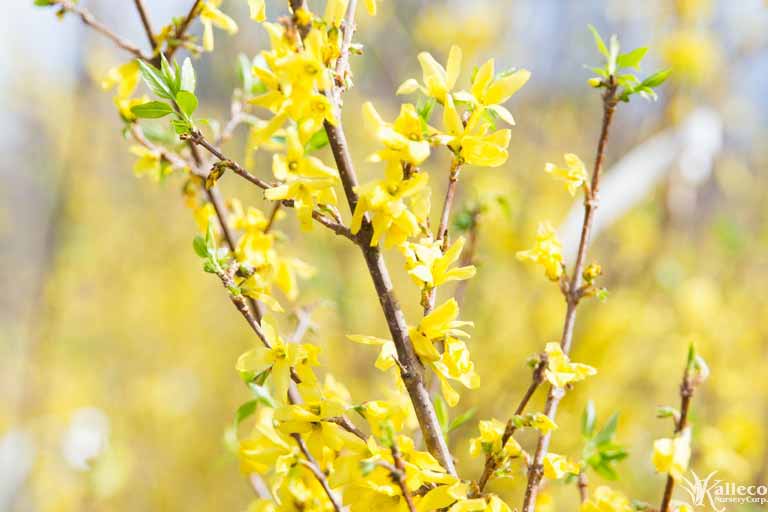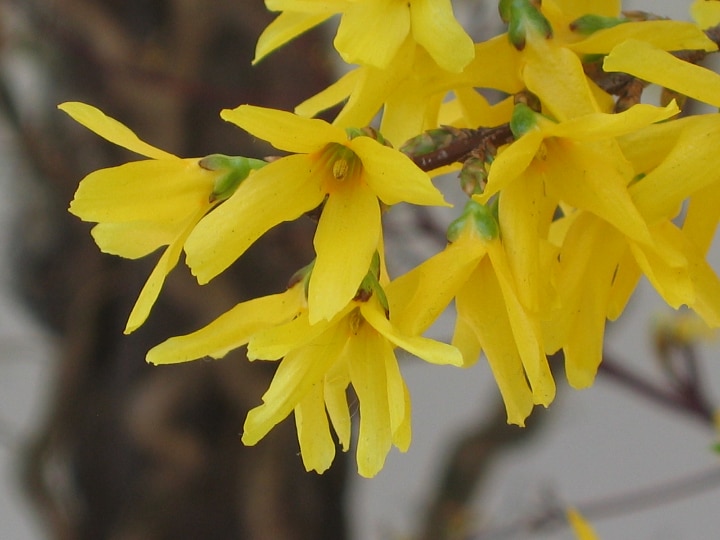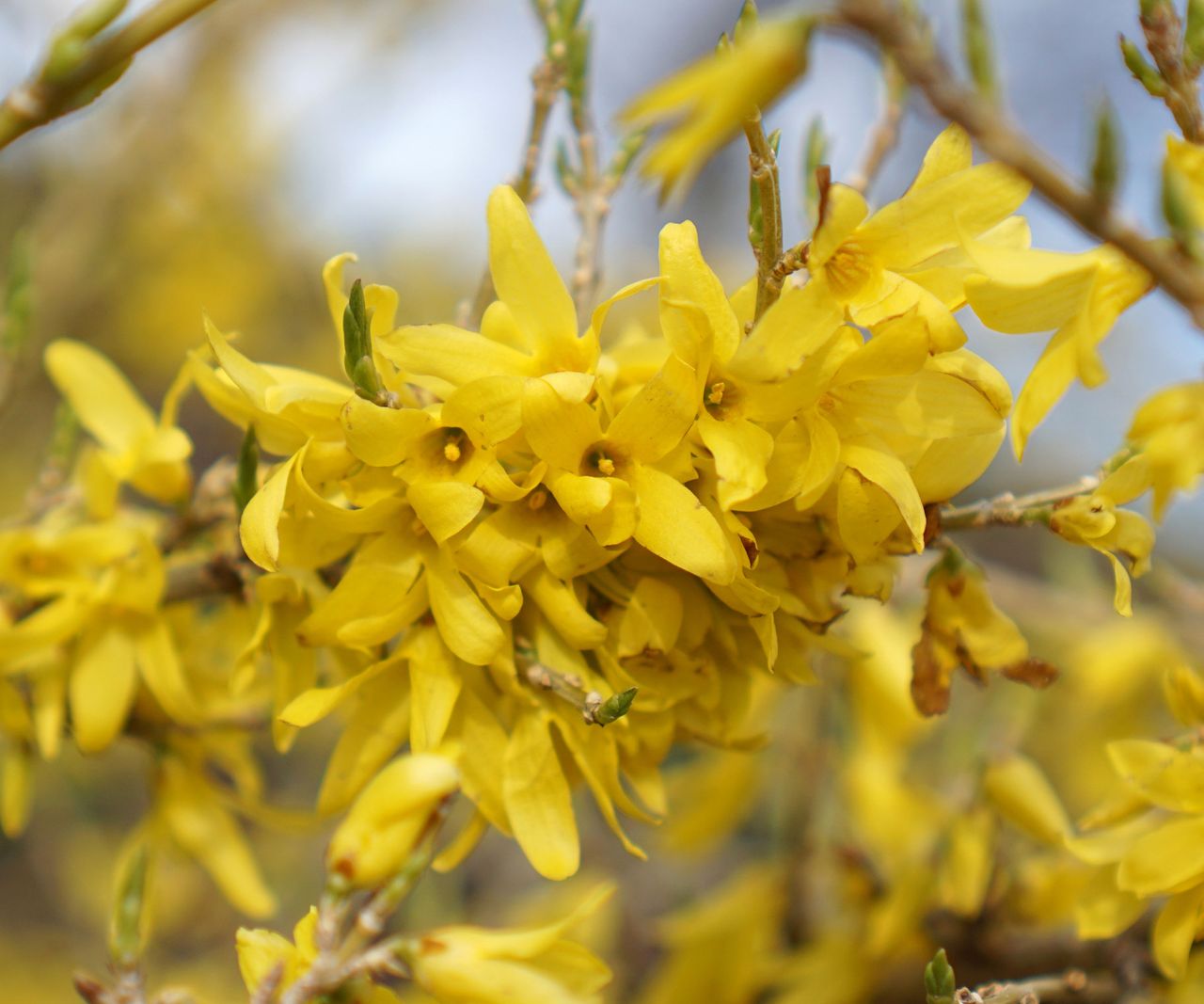Understanding Forsythia’s Growing Conditions
Forsythia is a versatile and adaptable shrub that can thrive in a variety of environments, but it still requires specific growing conditions to reach its full potential. When considering where to plant a forsythia, it’s essential to understand its basic needs. Forsythia prefers full sun to partial shade, with at least four hours of direct sunlight per day. This will help promote healthy growth, vibrant blooms, and a robust root system.
In terms of soil type, forsythia is relatively flexible and can grow in a range of soils, from clay to loam to sand. However, it does prefer well-draining soil with a slightly acidic pH, between 6.0 and 7.0. If your soil is heavy clay or prone to waterlogging, consider amending it with organic matter like compost or well-rotted manure to improve drainage and fertility.
Moisture levels are also crucial for forsythia’s success. While it can tolerate some drought, consistent moisture, especially during the first year after planting, will help establish a strong root system. Aim to provide about 1 inch of water per week, either through rainfall or supplemental irrigation.
By understanding forsythia’s growing conditions, you can create an optimal environment for your shrub to thrive. This will not only ensure its survival but also encourage it to produce an abundance of vibrant, yellow blooms that will brighten up your garden in early spring.
Assessing Your Yard’s Microclimate
When deciding where to plant a forsythia, it’s essential to consider the microclimate of your yard. A microclimate refers to the unique combination of environmental factors that exist in a specific area, such as wind direction, slope, and existing vegetation. Understanding your yard’s microclimate will help you determine the best location for your forsythia and ensure it receives the right conditions to thrive.
Wind direction is a critical factor to consider, as forsythia can be sensitive to strong winds. If your yard is exposed to harsh winds, look for a location that provides some protection, such as behind a building or a row of trees. On the other hand, if your yard is sheltered from the wind, you may be able to plant your forsythia in a more exposed location.
Slope is another important factor to consider. Forsythia prefers well-draining soil, so avoid planting in low-lying areas where water may collect. If your yard has a slope, consider planting your forsythia on the upper side of the slope to ensure good drainage.
Existing vegetation is also a crucial factor to consider. Forsythia can be used as a companion plant to enhance the beauty of other plants, but it can also compete with them for resources. Consider the mature size of your forsythia and the space requirements of other plants in your yard to ensure they coexist harmoniously.
By assessing your yard’s microclimate, you can identify the perfect spot for your forsythia and create a thriving and beautiful garden. Remember to consider the unique conditions of your yard and choose a location that meets the needs of your forsythia.
How to Choose the Ideal Location for Your Forsythia
When deciding where to plant a forsythia, there are several factors to consider to ensure you choose the ideal location. One of the most important considerations is proximity to other plants. Forsythia can be used as a companion plant to enhance the beauty of other plants, but it can also compete with them for resources. Consider the mature size of your forsythia and the space requirements of other plants in your yard to ensure they coexist harmoniously.
Accessibility for maintenance is another crucial factor to consider. Forsythia requires regular pruning to maintain its shape and promote healthy growth. Choose a location that is easily accessible for pruning and other maintenance tasks. Additionally, consider the location of nearby paths and walkways to ensure that your forsythia is not obstructing traffic or creating a hazard.
Aesthetic appeal is also an important consideration when choosing a location for your forsythia. Forsythia is a beautiful plant with vibrant yellow blooms that can add a pop of color to your garden. Consider the location of your forsythia in relation to other plants and features in your garden to create a visually appealing display.
Finally, consider the overall style and theme of your garden when choosing a location for your forsythia. Forsythia can be used in a variety of garden styles, from formal to informal, and can be paired with a range of other plants and features. Choose a location that complements the overall style and theme of your garden to create a cohesive and beautiful display.
By considering these factors, you can choose the ideal location for your forsythia and create a beautiful and thriving garden. Remember to think carefully about the needs of your forsythia and the overall style and theme of your garden to ensure that you choose the perfect spot.
Considering the Mature Size of Your Forsythia
When deciding where to plant a forsythia, it’s essential to consider the mature size of the plant. Forsythia can grow quite large, with some varieties reaching up to 10 feet tall and 8 feet wide. If you don’t take the mature size into account, you may end up with a plant that is too big for the space, leading to overcrowding and competition for resources.
To avoid this problem, consider the mature size of your forsythia when choosing a planting location. Make sure to leave enough space between the forsythia and other plants to allow for proper growth and air circulation. A general rule of thumb is to plant forsythia at least 3-5 feet away from other plants to ensure adequate space.
Additionally, consider the shape and form of your forsythia. Some varieties are more compact and upright, while others are more spreading and horizontal. Choose a location that takes into account the shape and form of your forsythia, and provides enough space for it to grow and thrive.
It’s also important to consider the potential impact of your forsythia on nearby plants and structures. For example, if you have a small garden bed with a variety of plants, you may want to choose a more compact forsythia variety to avoid overcrowding. On the other hand, if you have a large garden with plenty of space, you may be able to accommodate a larger forsythia variety.
By considering the mature size of your forsythia, you can choose a planting location that allows for proper growth and development, and avoids potential problems such as overcrowding and competition for resources.
Planting Forsythia in Different Types of Soil
Forsythia is a versatile plant that can thrive in a variety of soil types, including clay, loam, and sand. However, it does prefer well-draining soil with a slightly acidic pH, between 6.0 and 7.0. If your soil is heavy clay or prone to waterlogging, you may need to amend it with organic matter such as compost or well-rotted manure to improve drainage and fertility.
Clay soil can be challenging for forsythia, as it can be prone to waterlogging and nutrient deficiencies. To improve clay soil, add organic matter such as compost or well-rotted manure to improve drainage and fertility. You can also add perlite or vermiculite to improve soil structure and drainage.
Loam soil is ideal for forsythia, as it provides good drainage and fertility. Loam soil is a mix of clay, silt, and sand, and it retains moisture but drains excess water well. If your soil is loam, you may not need to amend it at all, but adding a layer of compost or well-rotted manure can still improve soil fertility and structure.
Sand soil can be challenging for forsythia, as it can be prone to drought and nutrient deficiencies. To improve sand soil, add organic matter such as compost or well-rotted manure to improve fertility and structure. You can also add peat moss or coconut coir to improve soil moisture retention.
Regardless of the soil type, it’s essential to test your soil pH and nutrient levels before planting forsythia. This will help you determine if your soil needs any amendments to create an optimal growing environment. You can purchase a soil testing kit or consult with a gardening expert to determine the best course of action for your soil.
Creating a Beautiful Display with Forsythia
Forsythia is a versatile plant that can be used as a decorative element in the garden, adding a pop of color and vibrancy to the landscape. When deciding where to plant a forsythia, consider how you can use it to create a beautiful display. Here are some ideas for using forsythia as a decorative element in the garden:
Companion Planting: Forsythia pairs well with a variety of plants, including spring-blooming bulbs, perennials, and shrubs. Consider planting forsythia alongside plants with complementary colors and textures to create a visually appealing display.
Hedges: Forsythia can be used to create a beautiful hedge, providing a natural screen and adding a pop of color to the landscape. Consider planting forsythia in a row, spacing the plants about 3-5 feet apart to create a dense hedge.
Borders: Forsythia can be used to create a beautiful border, adding a pop of color and vibrancy to the landscape. Consider planting forsythia alongside other plants with complementary colors and textures to create a visually appealing display.
Container Gardens: Forsythia can be used in container gardens, adding a pop of color and vibrancy to the landscape. Consider planting forsythia in a large container, using a well-draining potting mix and providing regular watering and fertilization.
By using forsythia as a decorative element in the garden, you can create a beautiful and vibrant display that adds color and interest to the landscape. Consider experimenting with different planting strategies and combinations to find the perfect look for your garden.
Common Mistakes to Avoid When Planting Forsythia
When planting forsythia, there are several common mistakes to avoid in order to ensure the best possible results. By being aware of these potential pitfalls, you can take steps to prevent them and create a thriving and beautiful forsythia plant.
Planting too deeply is one of the most common mistakes to avoid when planting forsythia. Forsythia prefers to be planted at the same depth as it was in the nursery, with the crown (where the stem meets the roots) level with the soil surface. Planting too deeply can cause the roots to rot and the plant to become waterlogged.
Planting in areas with standing water is another mistake to avoid. Forsythia prefers well-draining soil and can be susceptible to root rot if the soil is too wet. Make sure to choose a location with good drainage and avoid planting in low-lying areas where water may collect.
Not providing enough sunlight is also a common mistake to avoid. Forsythia prefers full sun to partial shade, so make sure to choose a location that receives at least 4-6 hours of direct sunlight per day.
Not watering enough is another mistake to avoid. Forsythia prefers consistent moisture, especially during the first year after planting. Make sure to water regularly, but avoid overwatering which can cause root rot.
By avoiding these common mistakes, you can create a thriving and beautiful forsythia plant that will provide years of enjoyment and beauty to your garden.
Conclusion: Finding the Perfect Home for Your Forsythia
Choosing the perfect spot for your forsythia requires careful consideration of several factors, including sunlight, soil type, moisture levels, and mature size. By understanding these factors and avoiding common mistakes, you can create a thriving and beautiful forsythia plant that will provide years of enjoyment and beauty to your garden.
Remember to assess your yard’s microclimate, consider the proximity to other plants, and choose a location that provides the right amount of sunlight and moisture. Also, don’t forget to consider the mature size of your forsythia and leave enough space for it to grow and thrive.
Experimenting with different locations and planting strategies can help you find the perfect home for your forsythia. Don’t be afraid to try new things and adjust your approach as needed. With a little patience and practice, you can create a stunning forsythia display that will be the envy of your neighbors.
By following the tips and guidelines outlined in this article, you can find the perfect spot for your forsythia and enjoy its beautiful blooms for years to come. Happy gardening!








